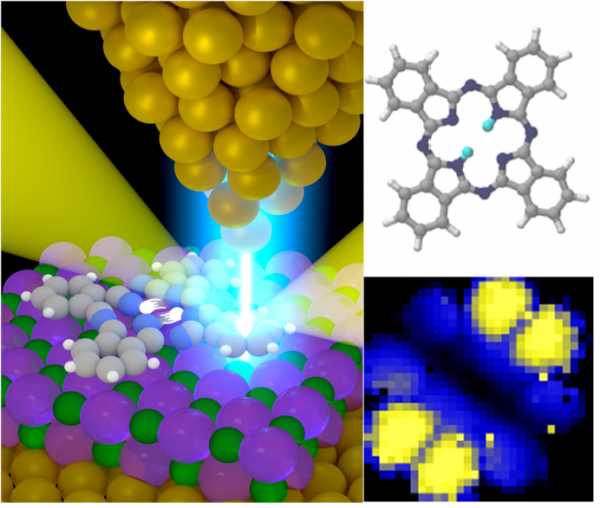Atomic-scale dissection of molecular flashes
Molecules are key building blocks for future optoelectronic devices at extremely low dimensions, as they can carry electronic current, emit photons, or switch on and off a signal. Thanks to an ultra-resolved nanoscopy technique, it is now possible to map the origin of light emitted from a switching molecule with intramolecular resolution.
Single-molecule devices open up functionalities that go beyond today’s electronics due to their intrinsic quantum nature. The concept of single molecule optoelectronics, which consists in combining optical and electronic properties within a single molecule, strongly emerges in this context. In molecular optoelectronics it is envisioned that light could be used to convey information at high frequency between well-separated components (atoms) within a single-molecule. This objective to access the molecular internal structure and its dynamics is closer thanks to the achievement by researchers at IPCMS of Strasbourg. These researchers implemented a nanoscopic technique which allowed to distinguish the exact origin of a molecular flash inside a molecule at the atomic scale. The team of researchers observed an unexpected blinking of the emitted light from the molecule, and together with theoretician colleagues from the “Theory of Nanophotonics” group at CFM in San Sebastian, they identified and associated the molecule’s flash fluctuation to the switching of hydrogen atoms between two positions of the molecule (about 1000 times per second), in a mechanism known as tautomerization. This result provides new information on this reaction, and shows that a molecule may be used as an intermittent emitter, potentially controllable, and relevant for optical communications at the nanoscale.
The researchers used the sharp metallic tip of a scanning tunneling microscope as an optical nanoantenna capable, simultaneously, of confining light to sub-molecular volumes and to excite a single-molecule with electrons. Located on top of a free-base phthalocyanine, a prototypical single-molecule switch, this nanoantenna was capable of amplifying the intensity of the molecular flashes by several orders of magnitude. By scanning the antenna with respect to the molecule, a spatial map of the flash emission was obtained with unprecedented atomic resolution. These results turn the dream of molecular optoelectronics into a closer reality.

Figure: (Left) Artistic view of the amplified fluorescence of a molecule induced by a nanoantenna tip. The two central hydrogen atoms are switching positions, and producing specific light flashes. (Right) Top: Structure of the phthalocyanine molecule under study. Bottom: Light-emission map with intramolecular resolution, allowing for identification of the origin of the flashes within the molecule.



